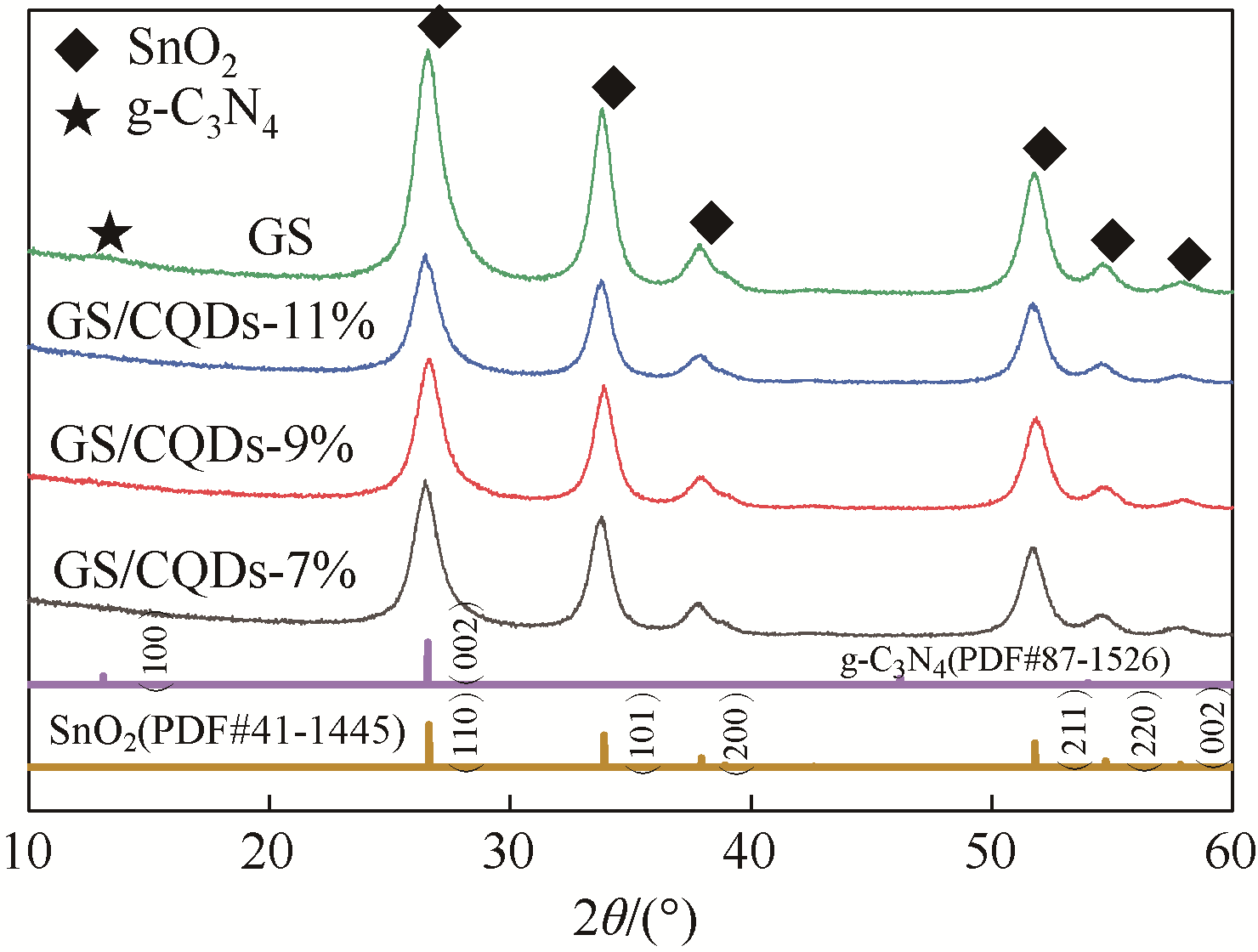| 1 |
LIU Yushan, LI Wei, WU Peng, et al. Preparation and applications of carbon quantum dots prepared via hydrothermal carbonization method[J]. Progress in Chemistry, 2018, 30(4): 349-364.
|
| 2 |
SHANG Wangji, CAI Tao, ZHANG Yunxiao, et al. Facile one pot pyrolysis synthesis of carbon quantum dots and graphene oxide nanomaterials: all carbon hybrids as eco-environmental lubricants for low friction and remarkable wear-resistance[J]. Tribology International, 2018, 118: 373-380.
|
| 3 |
LIU Yang, JIAO Yang, ZHANG Zhenglin, et al. Hierarchical SnO2 nanostructures made of intermingled ultrathin nanosheets for environmental remediation, smart gas sensor, and supercapacitor applications[J]. ACS Applied Materials & Interfaces, 2014, 6(3): 2174-2184.
|
| 4 |
RAMASAMY E, Jinwoo LEE. Ordered mesoporous SnO2-based photoanodes for high-performance dye-sensitized solar cells[J]. The Journal of Physical Chemistry C, 2010, 114(50): 22032-22037.
|
| 5 |
DONG Fan, WU Liwen, SUN Yanjuan, et al. Efficient synthesis of polymeric g-C3N4 layered materials as novel efficient visible light driven photocatalysts[J]. Journal of Materials Chemistry, 2011, 21: 15171-15174.
|
| 6 |
ZHANG Zhenzong, PAN Ziwei, GUO Yongfu, et al. In-situ growth of all-solid Z-scheme heterojunction photocatalyst of Bi7O9I3/g-C3N4 and high efficient degradation of antibiotic under visible light[J]. Applied Catalysis B: Environmental, 2020, 261: 118212.
|
| 7 |
SEZA A, SOLEIMANI F, NASERI N, et al. Novel microwave-assisted synthesis of porous g-C3N4/SnO2 nanocomposite for solar water-splitting[J]. Applied Surface Science, 2018, 440: 153-161.
|
| 8 |
CHEN Yingzhi, LI Wenhao, JIANG Dongjian, et al. Facile synthesis of bimodal macroporous g-C3N4/SnO2 nanohybrids with enhanced photocatalytic activity[J]. Science Bulletin, 2019, 64: 44-53.
|
| 9 |
PENG Fengping, NI Yaru, ZHOU Qiang, et al. New g-C3N4 based photocatalytic cement with enhanced visible-light photocatalytic activity by constructing muscovite sheet/SnO2 structures[J]. Construction and Building Materials, 2018, 179: 315-325.
|
| 10 |
MUTHUSANKAR G, SETHUPATHI M, CHEN Shenming, et al. N-doped carbon quantum dots@hexagonal porous copper oxide decorated multiwall carbon nanotubes: a hybrid composite material for an efficient ultra-sensitive determination of caffeic acid[J]. Composites Part B, 2019, 174: 106973.
|
| 11 |
ZHAO Chun, LIAO Zhenzhu, LIU Wen, et al. Carbon quantum dots modified tubular g-C3N4 with enhanced photocatalytic activity for carbamazepine elimination: mechanisms, degradation pathway and DFT calculation[J]. Journal of Hazardous Materials, 2020, 381: 120957.
|
| 12 |
DI Guanglan, ZHU Zhiliang, DAI Qi, et al. Wavelength-dependent effects of carbon quantum dots on the photocatalytic activity of g-C3N4 enabled by LEDs[J]. Chemical Engineering Journal, 2020, 379: 122296.
|
| 13 |
ZHU Youqi, LI Chao, CAO Chuanbao. Strongly coupled mesoporous SnO2-graphene hybrid with enhanced electrochemical and photocatalytic activity[J]. RSC Advances, 2013, 3: 11860-11868.
|
| 14 |
KRISHNAKUMAR T, JAYAPRAKASH R, PARTHIBAVARMAN M, et al. Microwave-assisted synthesis and investigation of SnO2 nanoparticles[J]. Materials Letters, 2009, 63: 896-898.
|
| 15 |
NARSIMULU D, VINOTH S, SRINADHU E S, et al. Surfactant-free microwave hydrothermal synthesis of SnO2 nanosheets as an anode material for lithium battery applications[J]. Ceramics International, 2018, 44(1): 201-207.
|
| 16 |
CHEN Yingzhi, LI Wenhao, JIANG Dongjian, et al. Facile synthesis of bimodal macroporous g-C3N4/SnO2 nanohybrids with enhanced photocatalytic activity[J]. Science Bulletin, 2019, 64: 44-53.
|
| 17 |
ZANG Yipeng, LI Liping, LI Xiaoguo, et al. Synergistic collaboration of g-C3N4/SnO2 composites for enhanced visible-light photocatalytic activity[J]. Chemical Engineering Journal, 2014, 246: 277-286.
|
| 18 |
LI Kui, SU Fengyun, ZHANG Weide. Modification of g-C3N4 nanosheets by carbon quantum dots for highly efficient photocatalytic generation of hydrogen[J]. Applied Surface Science, 2016, 375: 110-117.
|
| 19 |
WANG Fengliang, WANG Yingfei, FENG Yiping, et al. Novel ternary photocatalyst of single atom-dispersed silver and carbon quantum dots co-loaded with ultrathin g-C3N4 for broad spectrum photocatalytic degradation of naproxen[J]. Applied Catalysis B: Environmental, 2018, 221: 510-520.
|
| 20 |
TIAN Na, ZHANG Yihe, LI Xiaowei, et al. Precursor-reforming protocol to 3D mesoporous g-C3N4 established by ultrathin self-doped nanosheets for superior hydrogen evolution[J]. Nano Energy, 2017, 38: 72-81.
|
| 21 |
CHU Liangliang, ZHANG Jing, WU Zisheng, et al. Solar-driven photocatalytic removal of organic pollutants over direct Z-scheme coral-branch shape Bi2O3/SnO2 composites[J]. Materials Characterization, 2020, 159: 110036.
|
| 22 |
CAO Jianliang, QIN Cong, WANG Yan. Synthesis of g-C3N4 nanosheets decorated flower-like tin oxide composites and their improved ethanol gas sensing properties[J]. Journal of Alloys and Compounds, 2017, 728: 1101-1109.
|
| 23 |
PETR P, LADISLAV S, RICHARD D, et al. Nanocomposites of SnO2 and g-C3N4: preparation, characterization and photocatalysis under visible LED irradiation[J]. Ceramics International, 2018, 44(4): 3837-3846.
|
| 24 |
WANG Fengliang, CHEN Ping, FENG Yiping, et al. Facile synthesis of N-doped carbon dots/g-C3N4 photocatalyst with enhanced visible-light photocatalytic activity for the degradation of indomethacin[J]. Applied Catalysis B: Environmental, 2017, 207: 103-113.
|
| 25 |
PREKODRAVAC J, VASILJEVIĆ B, MARKOVIĆ Z, et al. Green and facile microwave assisted synthesis of (metal-free) N-doped carbon quantum dots for catalytic applications[J]. Ceramics International, 2019, 45: 17006-17013.
|
| 26 |
WU Yan, WANG Hou, TU Wenguang, et al. Petal-like CdS nanostructures coated with exfoliated sulfur-doped carbon nitride via chemically activated chain termination for enhanced visible-light-driven photocatalytic water purification and H2 generation[J]. Applied Catalysis B: Environmental, 2018, 229: 181-191.
|
| 27 |
霍朝晖, 杨晓珊, 陈晓丽, 等. 纳米银/二维石墨相氮化碳/还原氧化石墨烯复合材料的制备及其光催化降解抗生素[J]. 应用化学, 2020, 37(4): 471-480.
|
|
HUO Zhaohui, YANG Xiaoshan, CHEN Xiaoli, et al. Preparation of Ag/two-dimensional graphitic carbon nitride/reduced graphene oxide composite and its photocatalytic degradation of antibiotics[J]. Chinese Journal of Applied Chemistry, 2020, 37(4): 471-480.
|
| 28 |
ASADZADEH-KHANEGHAH S, HABIBI-YANGJEH A, VADIVEL S. Fabrication of novel g-C3N4 nanosheet/carbon dots/Ag6Si2O7 nanocomposites with high stability and enhanced visible-light photocatalytic activity[J]. Journal of the Taiwan Institute of Chemical Engineers, 2019, 103: 94-109.
|
 ), 许磊1,4(
), 许磊1,4( ), 夏仡3, 王学谦2, 刚瑞奇1, 王郎郎2
), 夏仡3, 王学谦2, 刚瑞奇1, 王郎郎2
 ), Lei XU1,4(
), Lei XU1,4( ), Yi XIA3, Xueqian WANG2, Ruiqi GANG1, Langlang WANG2
), Yi XIA3, Xueqian WANG2, Ruiqi GANG1, Langlang WANG2








